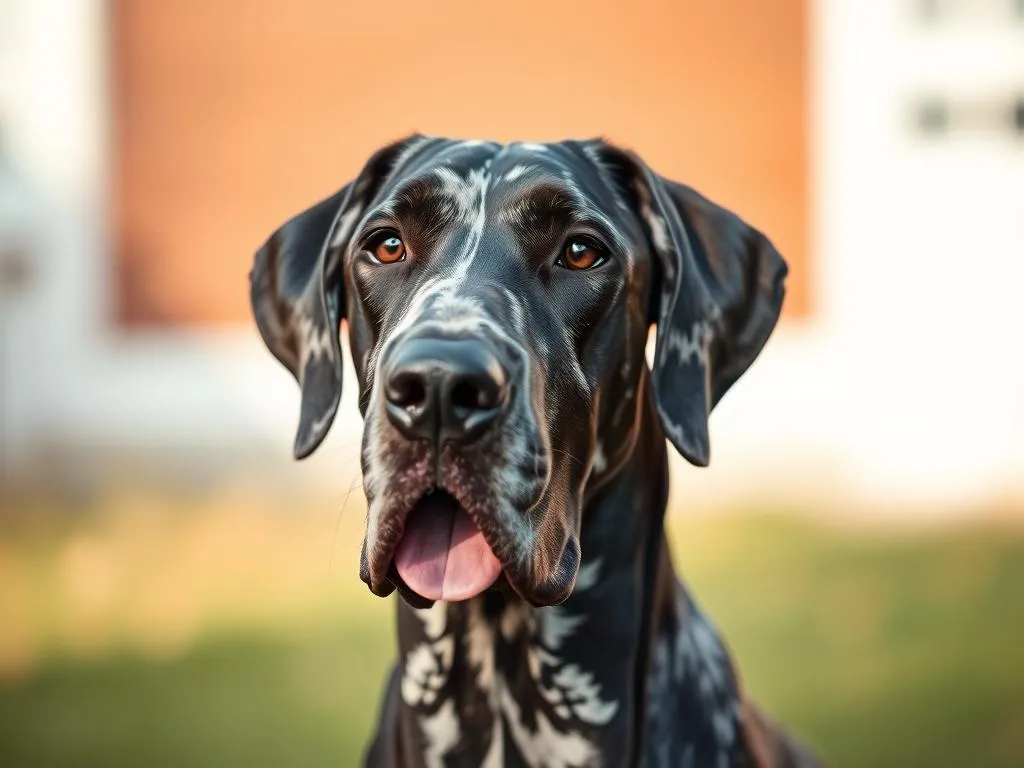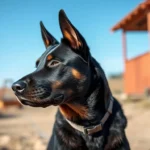
Introduction
Dog breeds have played a significant role in human society, providing companionship, protection, and assistance throughout history. Among the myriad of breeds, the Merle Great Dane stands out due to its distinct appearance and gentle temperament. Understanding the characteristics, care, and health of this unique breed is essential for potential owners. This article provides a comprehensive overview of the Merle Great Dane, ensuring that readers are well-informed about the breed’s particular needs and traits.
Understanding Dog Breeds
Definition of Dog Breeds
A dog breed is a group of dogs with specific characteristics, including size, shape, coat type, and temperament, that distinguish them from other breeds. These traits are often the result of selective breeding practices aimed at enhancing particular qualities, such as herding, guarding, or companionship. For dog owners, understanding breed characteristics is crucial as it directly impacts the dog’s behavior, care requirements, and compatibility with family life.
Importance of Breed Selection
When selecting a breed, several factors should be considered:
- Temperament: Different breeds exhibit varying personality traits, which can affect their suitability for families, singles, or seniors.
- Size: The size of the dog can impact space requirements and exercise needs.
- Care Requirements: Some breeds require more grooming or specific diets than others.
Understanding these factors can help prospective dog owners choose the right breed that fits their lifestyle and preferences.
Overview of Popular Dog Breeds
Among the most popular breeds are Labrador Retrievers, German Shepherds, and Golden Retrievers, each known for distinct traits. However, the Great Dane is often referred to as the “gentle giant” due to its impressive size and friendly nature. This breed deserves particular attention, especially when discussing the unique Merle Great Dane.
Overview of the Great Dane
General Characteristics
The Great Dane is one of the largest dog breeds, typically weighing between 110 to 175 pounds and standing about 28 to 34 inches tall at the shoulder. Despite their massive size, they have a relatively short lifespan of 7 to 10 years, which often raises health concerns for potential owners. Known for their friendly and affectionate temperament, Great Danes are generally good with children and other pets, making them excellent family companions.
Historical Background
Great Danes trace their origins back to ancient times, likely descending from mastiff-type dogs used for hunting large game and protecting estates. They have been depicted in art and literature throughout history, often associated with nobility and grandeur. Over time, they evolved into the gentle giants we know today, emphasizing companionship rather than their original hunting purpose.
Great Dane Variations
Great Danes come in various colors and patterns, including fawn, brindle, blue, black, and harlequin. Among these, the Merle pattern is particularly striking. This coat pattern features a mottled effect, with darker patches on a lighter background, often giving the dog a unique and eye-catching appearance.
The Merle Great Dane
What is the Merle Pattern?
The Merle pattern is a genetic variation characterized by patches of diluted color interspersed with darker shades. This pattern is a result of a specific gene that causes inconsistencies in pigmentation. The appearance can vary significantly from one dog to another, making each Merle Great Dane visually distinct.
Physical Characteristics of the Merle Great Dane
Merle Great Danes possess all the physical attributes of their breed, including a strong, muscular build and a regal stance. However, their coat patterns set them apart, often featuring a blend of gray, blue, or chocolate hues with a lighter base color. This unique coloration can make them particularly appealing to potential dog owners compared to standard Great Dane colors.
Temperament and Behavior
Merle Great Danes share the same temperament as other Great Danes, which is typically calm, affectionate, and friendly. However, some owners report that Merle Great Danes may exhibit a slightly more energetic demeanor, possibly due to their younger breeding lines. Regardless, they are generally good-natured and eager to please, making them excellent companions for families and individuals alike.
Care and Maintenance
Nutrition Requirements
Proper nutrition is critical for maintaining the health and well-being of a Merle Great Dane. A high-quality dog food formulated for large breeds is recommended, as it provides adequate nutrients to support their growth and weight. Owners should be aware of common dietary concerns, such as bloat, which affects Great Danes due to their deep chests. Feeding smaller, more frequent meals can help alleviate this risk.
Exercise Needs
Great Danes, including Merle Great Danes, require regular physical activity to stay healthy and happy. Daily walks, playtime, and mental stimulation are essential to prevent boredom and destructive behavior. A good routine may include at least one hour of exercise per day, tailored to the dog’s age and energy level.
Grooming and Maintenance
The grooming needs of a Merle Great Dane are relatively low, thanks to their short coat. Regular brushing helps minimize shedding and keeps their coat healthy. Essential grooming tools include a slicker brush and a rubber grooming mitt. Bathing should be done as needed, typically every few months, unless the dog gets into something dirty.
Health Considerations
Great Danes are prone to several health issues, including hip dysplasia, heart problems, and certain types of cancer. Merle Great Danes may also face specific concerns related to their coat pattern, such as deafness or vision problems. Regular vet check-ups and screenings can help catch potential health issues early, ensuring a longer, healthier life for your dog.
Training and Socialization
Training Basics
Early training is crucial for Great Danes, including Merle Great Danes. Their size can make them challenging to manage if not properly trained from a young age. Basic commands, leash manners, and house training should be prioritized. Positive reinforcement techniques, such as treats and praise, work best with this breed.
Socialization Practices
Socializing a Merle Great Dane from a young age is vital to help them develop into well-adjusted adults. Exposure to various environments, people, and other animals can help mitigate any potential behavioral issues. Group classes or puppy playdates can be excellent ways to ensure proper socialization.
Behavioral Issues
Like many large breeds, Great Danes can develop behavioral challenges, such as separation anxiety or excessive barking if not adequately trained or socialized. Consistent training, positive reinforcement, and providing sufficient exercise can help prevent these issues.
Choosing a Merle Great Dane
Finding a Responsible Breeder
When looking to acquire a Merle Great Dane, it’s essential to find a responsible breeder who prioritizes health and temperament. Potential owners should look for breeders who conduct health tests and provide a clean, safe environment for their dogs. Questions to ask include inquiries about health screenings, socialization practices, and the lineage of the puppies.
Adoption Considerations
Adopting a Great Dane can be a rewarding experience, providing a loving home to a dog in need. Many breed-specific rescue organizations focus on Great Danes and may have Merle Great Danes available for adoption. Prospective owners should consider the advantages of adopting, such as reduced costs and the fulfillment of giving a dog a second chance.
Cost of Ownership
Owning a Merle Great Dane involves various costs. Initial expenses, including purchase or adoption fees, can range from $1,500 to $3,000 or more. Ongoing costs, such as high-quality food, regular veterinary care, and grooming supplies, can add up to several hundred dollars per month, depending on the dog’s needs.
Conclusion
The Merle Great Dane is a unique and captivating breed that combines the grandeur of the Great Dane with a striking coat pattern. Understanding the breed’s characteristics, health needs, and care requirements is essential for any potential owner. Embracing the joys and responsibilities of owning a Merle Great Dane can lead to a rewarding companionship filled with love and loyalty.
FAQs
What is a Merle Great Dane?
A Merle Great Dane is a variation of the Great Dane breed characterized by a mottled coat pattern with lighter and darker patches.
Are Merle Great Danes prone to health issues?
Yes, like all Great Danes, Merle Great Danes can be susceptible to health issues such as hip dysplasia, heart problems, and specific concerns related to their coat pattern, including deafness and vision problems.
How much exercise do Merle Great Danes need?
Merle Great Danes require at least one hour of exercise per day, which can include walks, playtime, and mental stimulation.
Can Merle Great Danes be trained easily?
Yes, Merle Great Danes can be trained effectively using positive reinforcement techniques, especially when training begins at a young age.
Where can I find a Merle Great Dane?
You can find a Merle Great Dane through responsible breeders or rescue organizations specializing in Great Danes.









